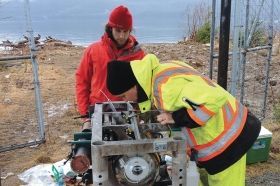The ocean is changing around the world—less oxygen, warmer water, higher acidity. The ability to quantify and observe those changes has never been more important, says Maia Hoeberechts, a scientist with the University of Victoria’s world-leading Ocean Networks Canada (ONC).
ONC launched in 2006 with the installation in Saanich Inlet of Canada’s first “wired” seafloor observatory. Since then, it has expanded to six observatories and more than 50 instrument platforms, with 900 km of fibre-optic cable now installed on the seafloor.
Since 2014, ONC has been installing smaller community observatories on Vancouver Island, along the BC coast and in the Arctic, partnering with First Nations and coastal communities to measure ship traffic, weather, underwater acoustics and more.
“An important aspect of understanding changes in the ocean is baseline monitoring,” says Hoeberechts, who is also associate director of user services for ONC. “You can’t evaluate change until you know what’s there already.”
Continue reading at University of Victoria.
Image via University of Victoria.


